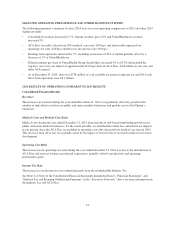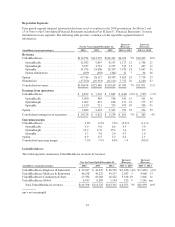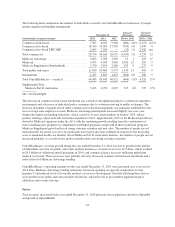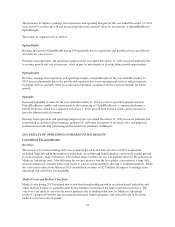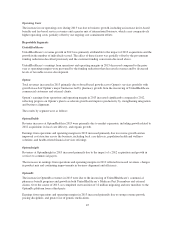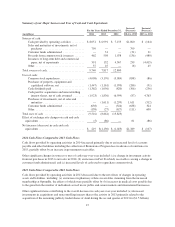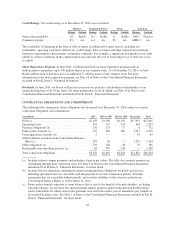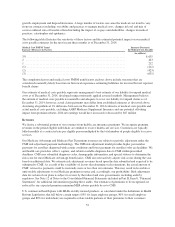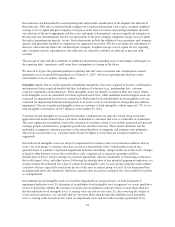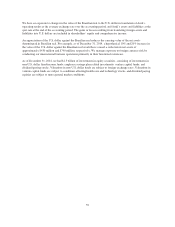United Healthcare 2014 Annual Report Download - page 53
Download and view the complete annual report
Please find page 53 of the 2014 United Healthcare annual report below. You can navigate through the pages in the report by either clicking on the pages listed below, or by using the keyword search tool below to find specific information within the annual report.
days from the date of service. Substantially all claims related to medical care services are known and settled
within nine to twelve months from the date of service. As of December 31, 2014, our days outstanding in medical
payables was 47 days, calculated as total medical payables divided by total medical costs times 365 days.
Each period, we re-examine previously established medical costs payable estimates based on actual claim
submissions and other changes in facts and circumstances. As more complete claim information becomes
available, we adjust the amount of the estimates and include the changes in estimates in medical costs in the
period in which the change is identified. Therefore, in every reporting period, our operating results include the
effects of more completely developed medical costs payable estimates associated with previously reported
periods. If the revised estimate of prior period medical costs is less than the previous estimate, we will decrease
reported medical costs in the current period (favorable development). If the revised estimate of prior period
medical costs is more than the previous estimate, we will increase reported medical costs in the current period
(unfavorable development). Medical costs in 2014, 2013 and 2012 included favorable medical cost development
related to prior years of $420 million, $680 million and $860 million, respectively.
In developing our medical costs payable estimates, we apply different estimation methods depending on the
month for which incurred claims are being estimated. For example, we actuarially calculate completion factors
using an analysis of claim adjudication patterns over the most recent 36-month period. A completion factor is an
actuarial estimate, based upon historical experience and analysis of current trends, of the percentage of incurred
claims during a given period that have been adjudicated by us at the date of estimation. For months prior to the
most recent three months, we apply the completion factors to actual claims adjudicated-to-date to estimate the
expected amount of ultimate incurred claims for those months. For the most recent three months, we estimate
claim costs incurred primarily by applying observed medical cost trend factors to the average per member per
month (PMPM) medical costs incurred in prior months for which more complete claim data is available,
supplemented by a review of near-term completion factors.
Completion Factors. Completion factors are the most significant factors we use in developing our medical costs
payable estimates for older periods, generally periods prior to the most recent three months. Completion factors
include judgments in relation to claim submissions such as the time from date of service to claim receipt, claim
inventory levels and claim processing backlogs as well as other factors. If actual claims submission rates from
providers (which can be influenced by a number of factors including provider mix and electronic versus manual
submissions) or our claim processing patterns are different than estimated, our reserves may be significantly
impacted.
The following table illustrates the sensitivity of these factors and the estimated potential impact on our medical
costs payable estimates for those periods as of December 31, 2014:
Completion Factors
Increase (Decrease) in Factors
Increase (Decrease)
In Medical Costs Payable
(in millions)
(0.75)% ................................................................. $318
(0.50) ................................................................... 212
(0.25) ................................................................... 106
0.25 .................................................................... (105)
0.50 .................................................................... (209)
0.75 .................................................................... (313)
Medical Cost PMPM Trend Factors. Medical cost PMPM trend factors are significant factors we use in
developing our medical costs payable estimates for the most recent three months. Medical cost trend factors are
developed through a comprehensive analysis of claims incurred in prior months, provider contracting and
expected unit costs, benefit design, and by reviewing a broad set of health care utilization indicators including,
but not limited to, pharmacy utilization trends, inpatient hospital census data and incidence data from the
National Centers for Disease Control. We also consider macroeconomic variables such as gross-domestic product
51


